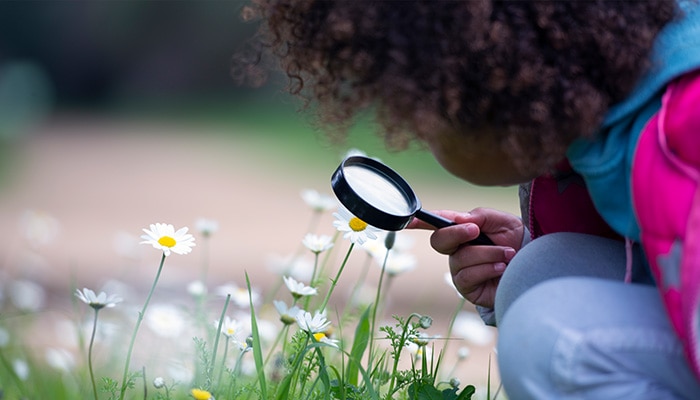While we believe that the books and resources recommended may be of value to you, keep in mind that these are suggestions only and you must do your own due diligence to determine whether the materials are appropriate and suitable for your use. PNC has no sponsorship or endorsement agreement with the authors or publishers of the materials listed.
OUTDOOR CLASSROOM

Nature's Beauty
Children will investigate flowers.

Lesson Objective
Children will use their senses to investigate flowers and will press flowers to preserve them.
Science
What You'll Need
- An outdoor area where flowers are present (see Lesson Tips)
- Flowers – 2 per child
- Magnifying glasses
- White drawing paper – 1 sheet per child
- Crayons or markers
- Newspaper – 1 sheet per child
- Heavy books (used as weights to press flowers) – 1 per child
What To Do
Note: This lesson involves a walk outside.
- Tell the children that they will be going for a nature walk to find flowers.
- Take the children for a walk outside.
- As the children find flowers, have them describe the flowers (see Guiding Student Inquiry).
- If possible, allow each child to collect 2 flowers (see Lesson Tips), and return to the classroom.
- Distribute magnifying glasses.
- Encourage the children to study the different parts of the flowers with the magnifying glasses and share their observations.
- Tell the children that the flowers will quickly wilt.
- Explain that flowers can be dried and pressed to preserve their beauty.
- Place each flower face-down on a sheet of newspaper.
- Cover with another sheet of newspaper.
- Place a heavy book on top and leave it in place for at least 2 weeks.
- Carefully remove the flowers, and have the children add them to their journals.
Resources
Home School Resources
Home educators: use these printable lesson PDFs to teach this lesson to your home schoolers. They're available in English and Spanish.
Content Provided By
Common Core State Standards Initiative – These lessons are aligned with the Common Core State Standards ("CCSS"). The CCSS provide a consistent, clear understanding of the concepts and skills children are expected to learn and guide teachers to provide their students with opportunities to gain these important skills and foundational knowledge [1]. Visit the CCSS


